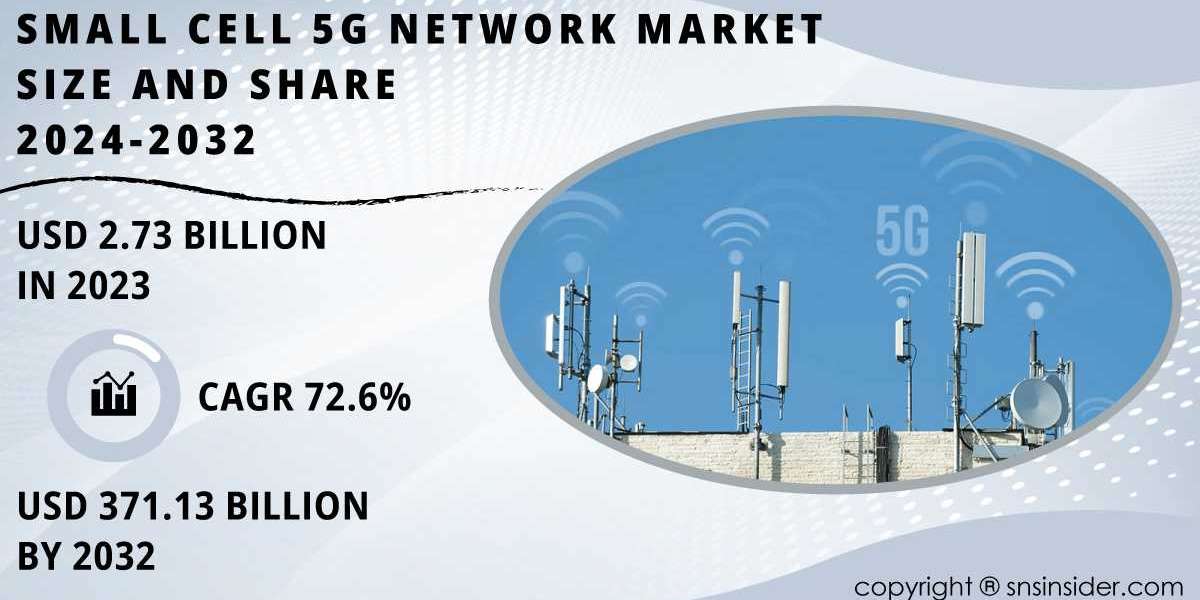Small Cell 5G Network 2024
The advent of 5G technology is transforming the way we connect, communicate, and conduct business. Among the key enablers of 5G’s potential is the deployment of small cell networks. Small cells are low-power, short-range base stations that provide wireless coverage in dense urban areas, enhancing network capacity and data throughput. These small, compact units are expected to play a crucial role in the rollout of 5G by filling coverage gaps, improving speed, and reducing latency. Small Cell 5G Network Market Trends suggest that the growing demand for higher data speeds, low latency, and improved mobile experiences is driving rapid adoption across various sectors, including telecom, enterprise, and smart city applications.
Small Cell 5G Network Market was valued at USD 2.73 billion in 2023 and is expected to grow to USD 371.13 billion by 2032 and grow at a CAGR of 72.6% over the forecast period of 2024-2032. This explosive growth reflects the increasing reliance on 5G networks for a variety of applications, ranging from autonomous vehicles and smart manufacturing to IoT and high-definition video streaming.
What are Small Cell 5G Networks?
Small cell 5G networks are miniaturized base stations that are typically installed in dense urban areas, on light poles, buildings, or street furniture, to improve mobile coverage and capacity. Unlike traditional large cell towers that cover wide geographical areas, small cells serve smaller areas, offering high-speed data and low-latency connections in localized regions. These small cells connect to larger cellular networks but operate independently in their limited coverage zones, offering seamless connectivity to users.
Small cells come in different types, including femtocells, picocells, and microcells, with varying power outputs and coverage areas. They are crucial for the full deployment of 5G, which requires a dense network of low-range base stations to deliver ultra-fast speeds and low latency. With 5G promising to support a multitude of devices and applications, small cells act as an effective solution for alleviating network congestion in high-traffic areas.
Applications and Use Cases of Small Cell 5G Networks
Small cell 5G networks have vast applications in both urban and rural environments, especially where there is a need for high-speed internet, low latency, and efficient coverage. One of the most significant areas where small cell networks are utilized is in urban settings, where the high density of mobile users requires seamless connectivity. Small cells are deployed in places such as stadiums, shopping malls, airports, and office buildings, improving network performance in crowded spaces.
In addition to urban environments, small cell networks are also essential in supporting IoT (Internet of Things) infrastructure. The 5G network's capacity for handling massive numbers of devices simultaneously is facilitated by the deployment of small cells, enabling smart cities, automated factories, and connected vehicles to function more efficiently. For instance, self-driving cars rely on low-latency 5G networks powered by small cells to communicate in real-time with other vehicles and infrastructure, enhancing road safety and enabling intelligent traffic management.
The role of small cells in expanding 5G coverage is also critical in rural and underserved areas. Small cell deployments help improve network coverage where traditional cell towers might not be feasible due to geographic constraints or infrastructure costs.
Benefits of Small Cell 5G Networks
Small cell 5G networks offer several advantages that make them essential to the future of mobile connectivity. One of the primary benefits is improved network efficiency. Small cells reduce network congestion by offloading traffic from macro cells, ensuring better coverage and faster speeds in densely populated areas. This leads to more efficient use of the available spectrum and enhanced network performance.
Another key benefit is the reduction in latency. With small cells positioned closer to the end user, data transmission times are minimized, making real-time applications like virtual reality (VR), augmented reality (AR), and remote surgeries possible. This low-latency capability is crucial for applications requiring immediate data processing and response.
Small cells also contribute to cost-effectiveness for network operators. They are more affordable to install and maintain than large cell towers, which require significant infrastructure investment. The flexibility of small cell installation also allows for faster network deployment, especially in urban areas where space is limited.
Challenges and Considerations
While small cell 5G networks offer substantial benefits, their deployment comes with challenges. One significant hurdle is regulatory approval, as the installation of small cells often requires permits and coordination with local governments, especially when they are mounted on public infrastructure. Issues related to zoning, permits, and infrastructure-sharing must be addressed to ensure smooth implementation.
Another challenge is the need for a dense and interconnected small cell network. Small cells rely on each other to provide seamless coverage, and ensuring that these small cells are interconnected with high-performance backhaul networks is essential for maintaining high data speeds and low latency. This requires significant investment in both hardware and infrastructure.
The Future of Small Cell 5G Networks
The rapid growth of the Small Cell 5G Network Market signals a bright future for this technology. As demand for faster, more reliable mobile networks continues to rise, the adoption of small cells will become more widespread. Future innovations, such as edge computing and the expansion of IoT devices, will further propel the need for small cell networks, ensuring that 5G connectivity remains robust and accessible.
In conclusion, small cell 5G networks are set to play a pivotal role in realizing the full potential of 5G technology. Their ability to provide high-speed, low-latency, and efficient coverage in urban, rural, and industrial settings positions them as a cornerstone of the next generation of mobile networks. As the market continues to grow, small cells will enable a wide range of new applications, driving innovation across industries and enhancing the mobile experience for consumers around the globe.
Contact Us:
Akash Anand – Head of Business Development Strategy
info@snsinsider.com
Phone: +1-415-230-0044 (US) | +91-7798602273 (IND)
About Us
SS Insider is one of the leading market research and consulting agencies that dominates the market research industry globally. Our company's aim is to give clients the knowledge they require in order to function in changing circumstances. In order to give you current, accurate market data, consumer insights, and opinions so that you can make decisions with confidence, we employ a variety of techniques, including surveys, video talks, and focus groups around the world.
Read Our Other Reports:














